Compliance audits in 2025 demand precision and advanced technology. With digital assets now valued at $3 trillion, regulatory scrutiny has intensified, especially in areas like cryptocurrency, copyright, and licensing. This article highlights 10 tools designed to simplify compliance, reduce risks, and meet legal standards. Here’s a quick overview of the top solutions:
- ScoreDetect: Protects digital content using AI, blockchain timestamping, and watermarking.
- Cryptoworth: Tracks cryptocurrency portfolios across 230+ blockchains and exchanges.
- InvGate Asset Management: Manages software licenses with automated tracking and alerts.
- Cryptio: Provides detailed audit trails for digital asset transactions.
- Ledgible: Focuses on crypto accounting with tax reporting and compliance features.
- Tenable Nessus: Scans for vulnerabilities and compliance issues in IT systems.
Each tool offers unique features tailored to industries like finance, healthcare, media, and government. Whether you’re securing digital assets, managing crypto, or ensuring software compliance, these tools streamline audits and help businesses avoid costly penalties. Read on to learn how these solutions can fit your compliance strategy.
5 Best Compliance Management Software Tools (2024)
1. ScoreDetect: Digital Content Protection for Compliance
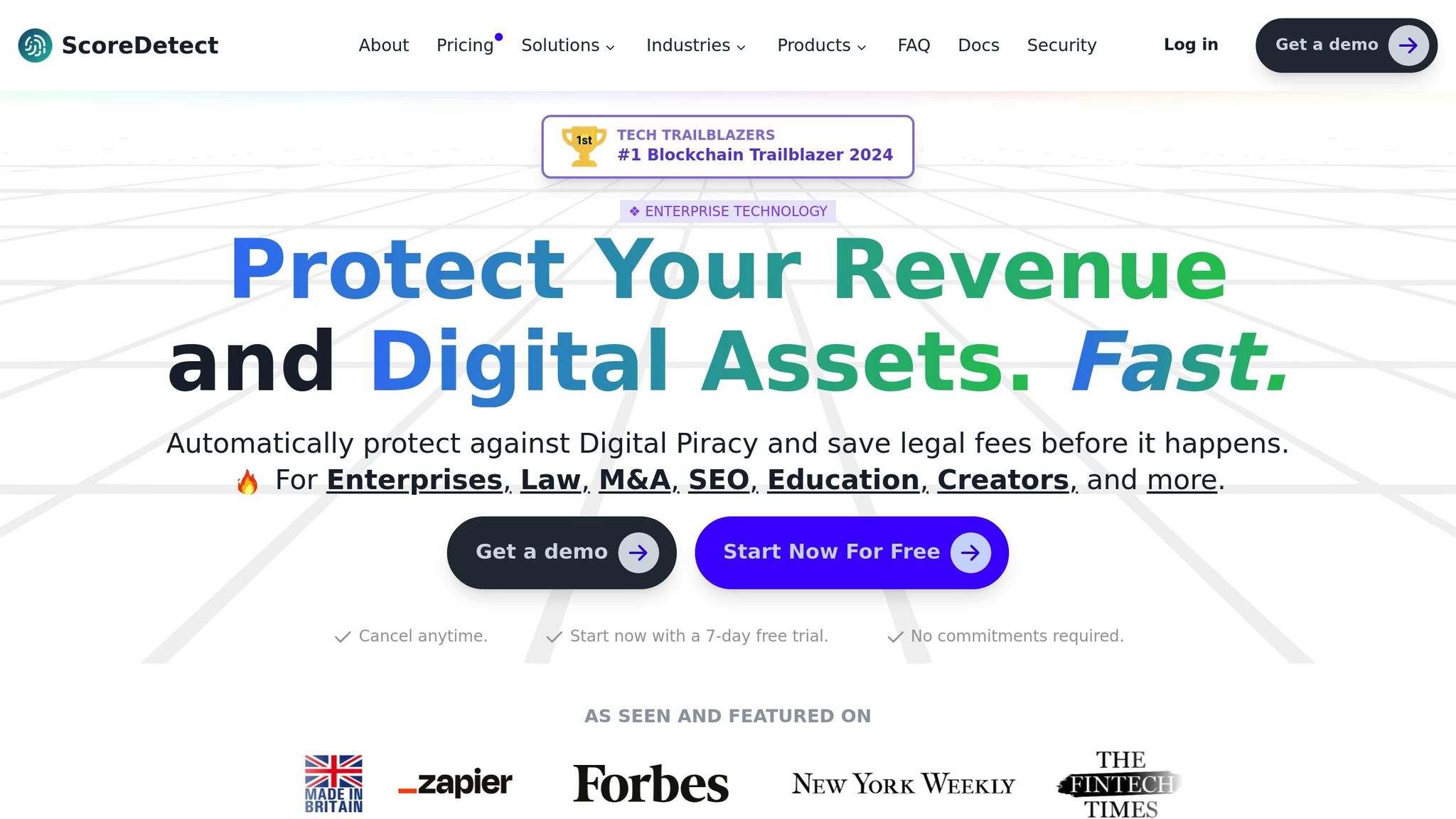
ScoreDetect is leading the charge in digital content protection, offering a streamlined solution tailored for the compliance audits of 2025. As businesses increasingly rely on AI and automation to cut costs and reduce human error in compliance management [1], ScoreDetect leverages advanced AI to safeguard digital assets while ensuring they meet regulatory standards.
This platform addresses a significant concern in the compliance world, where 64% of consumers believe their country’s privacy regulations fall short in protecting them [2]. By integrating invisible watermarking, intelligent content discovery, blockchain timestamping, and automated takedown capabilities, ScoreDetect provides a comprehensive framework that aligns with today’s demanding regulatory requirements. Its functionality fits seamlessly into the broader compliance strategies discussed throughout this article.
Key Features for Compliance Audits
ScoreDetect’s functionality revolves around four main features, each designed to create robust audit trails and protection mechanisms:
- Invisible Watermarking: This feature embeds unnoticeable markers into digital content, offering undeniable proof of ownership and usage rights. It also generates tamper-proof records that can serve as legally valid evidence during audits.
- Web Scraping: With a 95% success rate in bypassing anti-scraping measures, ScoreDetect enables organizations to track unauthorized usage of their digital assets across the internet. This capability is vital for demonstrating due diligence in protecting assets during compliance audits.
- Blockchain Timestamping: By capturing content checksums rather than storing the actual assets, this feature supports data minimization – a key compliance principle. As Shrav Mehta of Secureframe explains:
"Data minimization is fundamental to effective risk reduction. Organizations must develop a clear prioritization strategy – identifying their most critical assets and building targeted security measures around them." [2]
- Automated Takedown System: Achieving a 96% removal success rate, this feature provides documented proof of proactive enforcement actions, a growing requirement in compliance audits.
How It Supports Licensing and Certification
Beyond audit readiness, ScoreDetect simplifies licensing and certification processes. Its blockchain integration automates the creation of verifiable records, ensuring proof of ownership for digital assets. For example, its WordPress plugin automatically logs every published or updated article, creating immutable records that not only support compliance but also enhance SEO performance through Google’s E-E-A-T (Experience, Expertise, Authoritativeness, Trustworthiness) framework.
For organizations using the Pro plan, ScoreDetect generates verifiable certificates, enabling comprehensive documentation of digital assets throughout their lifecycle. With integration options for over 6,000 web applications via Zapier, the platform automates compliance workflows, reducing manual oversight while maintaining the integrity of audit trails. This aligns with the growing trend of using AI and automation to manage compliance [1].
Industries Served
ScoreDetect caters to a variety of industries, each with unique compliance needs. Here’s how it addresses specific challenges:
- Finance and Banking: Protects sensitive financial documents and ensures compliance with increasingly stringent data protection laws through automated workflows.
- Government Agencies: Uses blockchain timestamping and watermarking to maintain document integrity and prevent unauthorized distribution, supporting transparency and accountability.
- Healthcare: Safeguards patient data and ensures HIPAA audit readiness with tools like invisible watermarking, which tracks sensitive medical documents without compromising privacy.
- Legal and Law Firms: Provides comprehensive audit trails and blockchain verification to protect client confidentiality and uphold attorney-client privilege. Its takedown capabilities help law firms swiftly address unauthorized disclosures of sensitive documents.
- Media and Entertainment: Combats digital piracy with watermarking and automated takedown features, ensuring compliance with copyright laws and licensing agreements.
2. Cryptoworth: Crypto Asset Tracking and Compliance
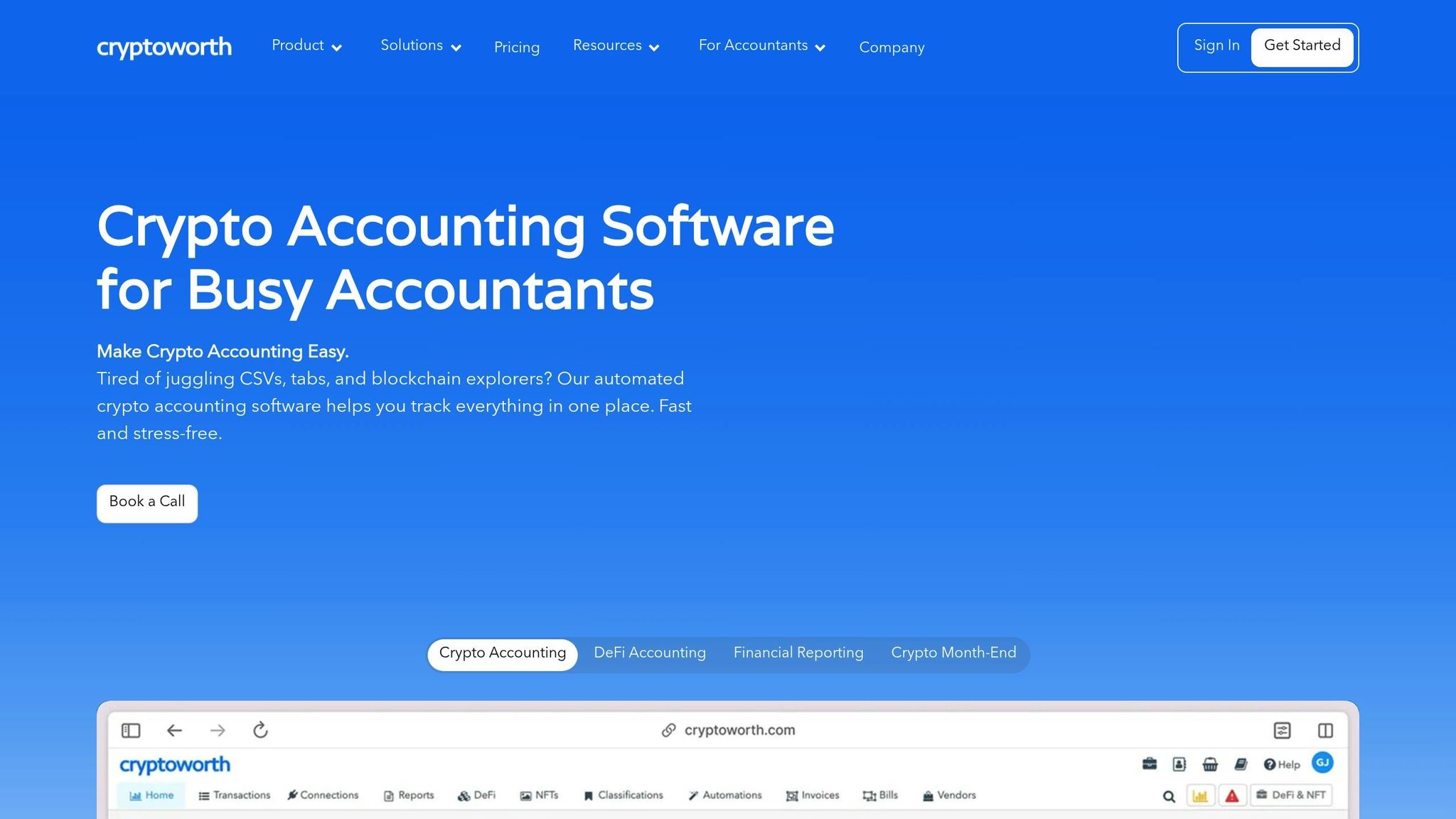
Cryptoworth simplifies cryptocurrency asset management for organizations grappling with the intricate world of digital asset compliance. With the IRS introducing new rules under Rev. Proc. 2024-28, businesses now face the challenge of implementing systems capable of wallet-level reporting and maintaining detailed audit trails across various blockchain networks.
For finance teams, the platform solves a major issue: the inefficiency of managing growing crypto portfolios with manual spreadsheets. Cryptoworth automates reconciliation across wallets and exchanges, enabling accounting teams to streamline compliance, minimize audit risks, and eliminate spreadsheet errors [3]. This automation also paves the way for real-time, reliable audit features.
Main Audit Features
Cryptoworth’s audit capabilities focus on three key areas, offering tools that auditors and compliance teams can rely on.
Transaction Consolidation Across Networks
The platform aggregates transactions from over 230 blockchains, exchanges, and protocols into a unified audit trail [5]. This comprehensive view ensures the level of oversight auditors require.
Transaction Segregation and Cost Basis Tracking
Cryptoworth categorizes transactions by individual wallets and accounts, while tracking the cost basis for each wallet to comply with IRS standards [3]. This granular approach is critical for meeting the IRS’s new wallet-specific reporting requirements.
Richard Pasquin from Cryptoworth highlights the ease of adapting to compliance changes:
"With Cryptoworth, we make it as easy as a click of a button to switch the accounting methodology." [4]
Detailed Reporting and Documentation
The platform generates GAAP- and IFRS-compliant reports, complete with audit trails that document every change, approval, user action, and daily balance snapshot [5]. These records become invaluable during audits, providing the transparency needed to validate financial data.
Real-Time Monitoring and Verification
To meet audit standards, Cryptoworth offers secure access to daily asset snapshots, enabling quick and accurate verification of data [5]. Built-in controls and checks ensure the accuracy of prices, balances, and cost basis for all assets [5].
The efficiency of Cryptoworth is evident in its results – audit preparation time is reduced from months to just a few weeks [5]. For businesses racing against compliance deadlines, this time savings could mean avoiding penalties and staying on track with regulatory demands.
Integration with Accounting Systems
Cryptoworth goes beyond audit trails by seamlessly integrating with accounting systems, bridging the gap between digital asset data and traditional accounting workflows. This capability strengthens a business’s overall compliance framework.
The platform works with popular accounting tools like QuickBooks, Xero, and NetSuite, enabling two-way syncing for invoices, bills, and journal entries [6]. Users can set up custom transaction mapping based on location, department, or asset type within their accounting software [6]. Additionally, automation features allow businesses to classify spam tokens, NFTs, and specific transaction types effortlessly [6], a crucial tool as crypto portfolios grow more diverse.
Hans Hao, Associate Director at The Catalyst Group, shared how Cryptoworth has transformed their processes:
"Cryptoworth has been a great partner for our business. They have streamlined our data ingestion process and the rapid turnaround times have helped us to keep up with our growing customer demands." [7]
Extensive Data Connectivity
Cryptoworth offers over 1,000 data connections, including support for more than 200 blockchain networks, cryptocurrency exchanges, custodians, and DeFi protocols [6]. This wide-ranging connectivity allows businesses to consolidate data from virtually any crypto source into their compliance workflows.
To address security concerns, Cryptoworth holds a SOC 2 Type 2 certification [5], ensuring that its data integration meets enterprise-grade security standards. For compliance teams, this certification provides peace of mind, knowing that their audit trails remain secure and intact throughout the integration process.
3. InvGate Asset Management: Software Asset Compliance
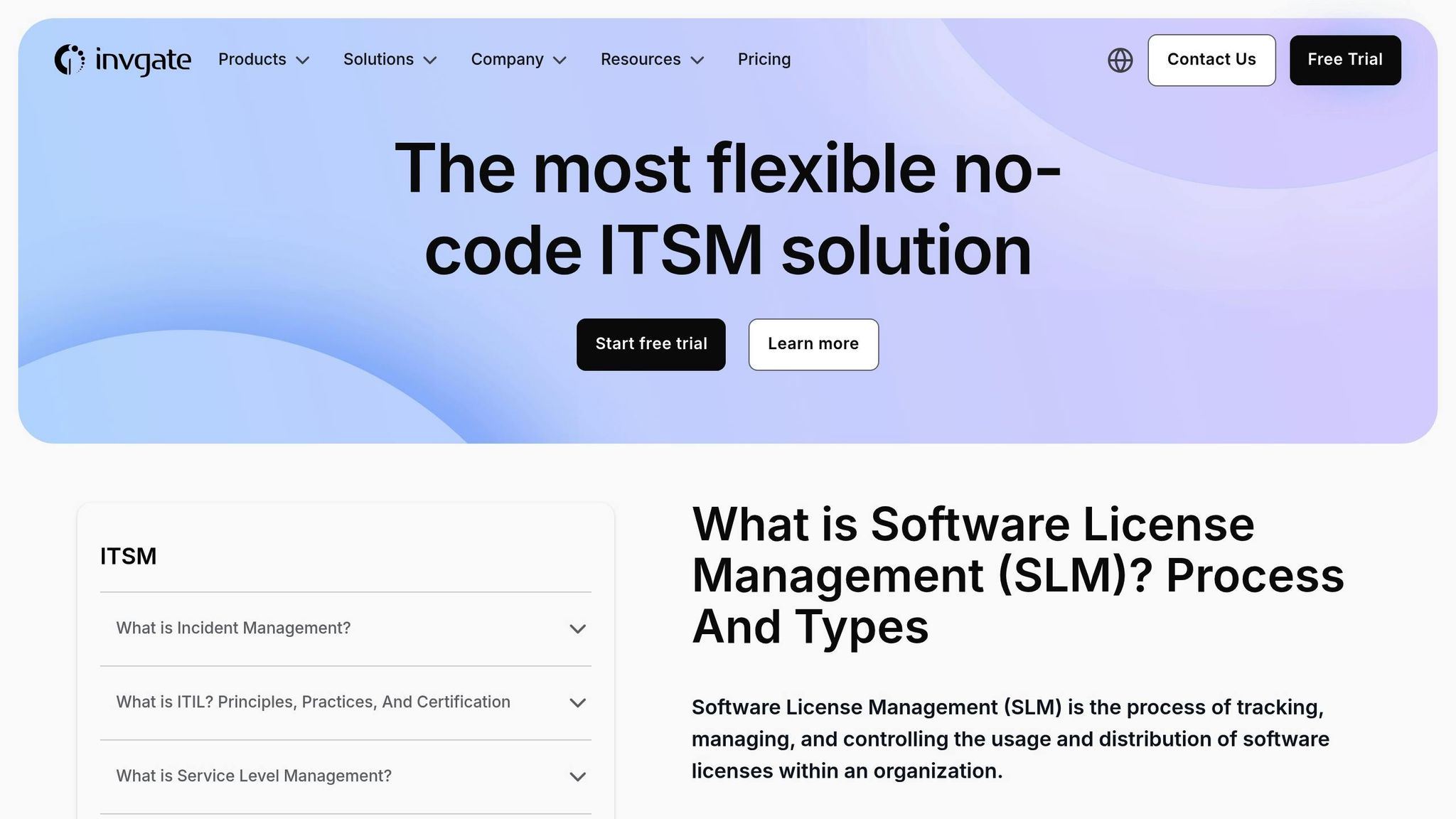
InvGate Asset Management tackles the challenges of software license management in today’s complex IT environments. With nearly 32% of organizations facing audit-related costs exceeding $1 million [8], the importance of effective software asset management is hard to overstate.
This platform helps organizations maintain a detailed inventory that links software applications to licenses, users, devices, and contracts. By centralizing this information, InvGate eliminates the guesswork that often leads to costly audit surprises. Its ability to continuously monitor installed applications and track real-time usage becomes especially valuable when auditors request proof during unexpected reviews.
The impact on operational efficiency is striking. Ayelen Rodriguez, Head of Support and Microinformatics at Mirgor, shares her experience:
"With InvGate Asset Management we reduced 80% of the time spent on Operational Management. It has been a paradigm shift that has helped us make more agile and strategic decisions" [11]
Features That Help Ensure Compliance
InvGate Asset Management offers a suite of features aimed at simplifying and strengthening compliance efforts. Here’s how it stands out:
Automated License Monitoring
The platform uses automated cross-referencing to match license contracts with real-time usage data. This minimizes manual work and reduces the risk of human error during compliance checks.
Proactive Alerts
InvGate generates automated notifications for expiring licenses and potential compliance issues [9]. These alerts help organizations avoid last-minute surprises during audits.
Cost Management and Renewal Tracking
With tools to monitor spending, set renewal reminders, and prevent unexpected license expirations, InvGate helps organizations cut down on software waste. Gartner predicts these features could reduce software spending waste by up to 60% by 2026 [12].
Automation and Smart Tagging
The platform’s custom automation and smart tagging features make it easier to manage license limits and renewal schedules. These tools keep compliance teams ahead of potential issues.
Mariano Pereira, IT Services Coordinator at Camuzzi, highlights the time savings:
"With InvGate Asset Management we automated all key Asset Management processes, saving +1000 hours of work per year for our IT team" [11]
CMDB Integration
By mapping licenses to the Configuration Management Database (CMDB), InvGate ties compliance data to broader IT operations. This integration provides valuable context for troubleshooting, support, and license planning.
Detailed Reporting and Dashboards
Customizable dashboards and reports track license usage, compliance risks, and potential savings. These tools are invaluable during audit preparation, providing the documentation auditors expect to see.
These features not only simplify internal compliance but also make it easier to validate licenses for digital assets.
Simplifying Digital Licensing
InvGate provides a centralized approach to managing digital assets, ensuring compliance across various software categories and licensing models. Its ability to generate audit-ready reports streamlines the process of demonstrating compliance [10].
Regulatory Compliance Made Easier
The platform supports structured policies and automated documentation, helping organizations prepare for both internal reviews and external audits [11].
Real-Time Monitoring
InvGate maintains an up-to-date inventory of devices, software, and licenses, making it easier to identify unauthorized or non-compliant assets. It also tracks policy enforcement, audit trails, and configuration changes in real time [11]. This continuous monitoring is crucial, as 60% of security breaches stem from mismanaged or ungoverned access and configurations [11].
Guido Javier Mendez Palavecino, Head of IT, emphasizes the platform’s simplicity:
"InvGate Asset Management’s virtue is that it doesn’t have great complexity. It’s always kept in a simple environment, making it easy to manage and use, and intuitive for people"
Pricing Accessibility
InvGate’s flexible pricing starts at $0.21 per node/month for the Starter Plan (minimum $1,250/year) [10]. This makes it a practical choice for organizations of all sizes looking to enhance their software compliance efforts.
4. Cryptio: Digital Asset Compliance and Audit Trails
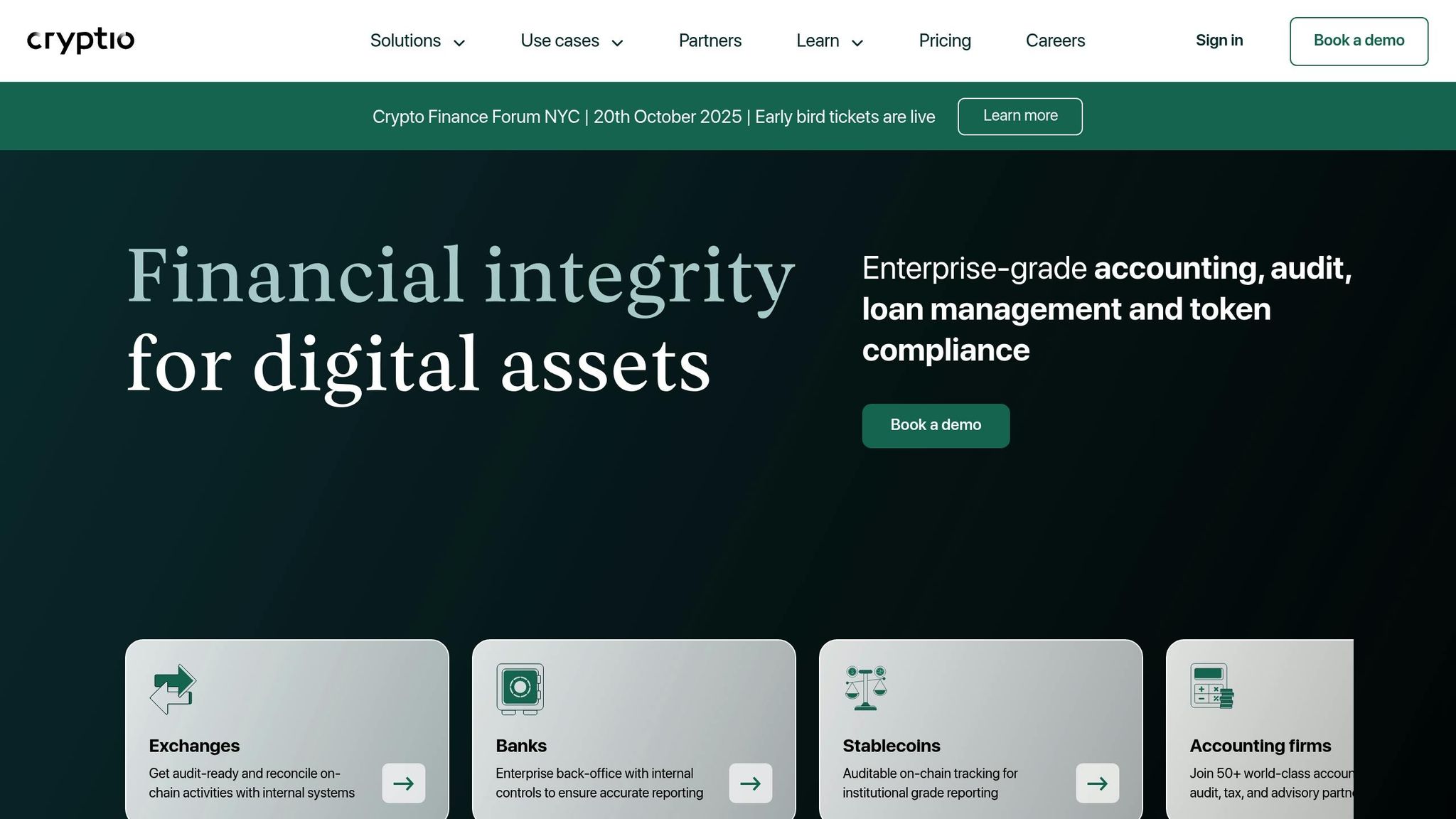
Cryptio provides essential tools for digital asset organizations to navigate the ever-evolving regulatory environment and meet stringent compliance standards [13]. By offering detailed audit trails and thorough documentation, Cryptio ensures both internal teams and external regulators have the clarity they need. Additionally, these tools support senior management in maintaining oversight, which is a key regulatory requirement [13].
Key Audit Features
Cryptio focuses on making digital asset transactions fully traceable and easily accessible for review. Given the intricate licensing and registration requirements in the digital asset space [14], Cryptio simplifies the process by keeping detailed records of asset movements. This commitment to transparency and meticulous documentation helps companies stay compliant with increased regulatory demands [13]. The result? A seamless system for regulatory reporting that’s always audit-ready [13].
Creating Accurate Audit Trails
By providing clear and precise documentation, Cryptio not only aids internal evaluations but also streamlines regulatory reporting. This positions organizations to adapt effectively as traditional financial institutions expand their involvement in digital assets [13].
sbb-itb-738ac1e
5. Ledgible: Crypto Accounting and Audits
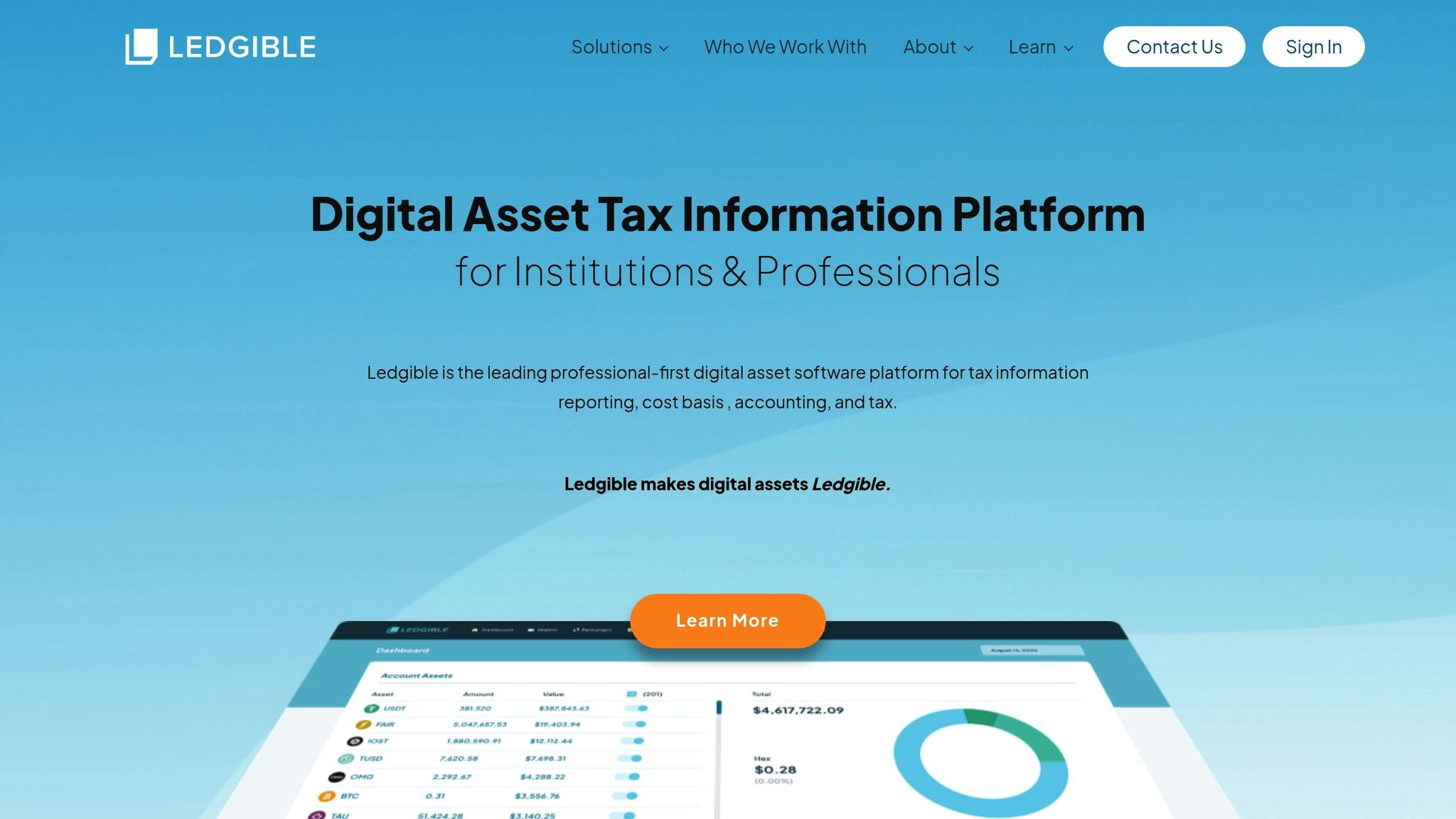
Ledgible has carved out its niche as a go-to cryptocurrency accounting platform for CPAs and tax professionals managing digital asset portfolios [17]. In 2023, it was named a Top Crypto and Digital Asset Tool by Accounting Today, underscoring its role in simplifying compliance for financial professionals [16].
What makes Ledgible a standout choice is its AICPA SOC 1 & 2 Type 2 certified security, which adheres to the highest standards for safeguarding sensitive financial data [15][17]. This certification has earned the trust of major financial institutions worldwide, including top-tier U.S. banks, investment firms with over $1 billion in assets under management, and leading cryptocurrency exchanges [20].
Ledgible bridges the gap between traditional accounting systems and the complexities of managing cryptocurrency. By aligning with established accounting workflows, the platform allows professionals to integrate crypto data seamlessly into their current systems without disrupting operations [17]. With real-time monitoring of holdings across wallets and exchanges, it ensures accurate reporting and calculates cost basis efficiently, making tax planning more proactive [16]. These capabilities naturally extend to its robust audit features.
Audit and Reporting Features
Ledgible takes its accounting integration a step further with comprehensive audit and reporting tools, making compliance less daunting. The platform connects effortlessly with leading exchanges and accounting software, such as QuickBooks, Xero, Sage Intacct, Oracle NetSuite, TurboTax, TaxAct, Coinbase, Binance, Kraken, and Gemini [17]. This creates a unified system for managing digital assets. Its sub-ledger system and advanced reporting capabilities generate essential tax forms, including 8949, 1099, and Schedule D, while also enabling real-time reconciliation and fee accounting [15][16][19].
Ledgible also supports customized reporting compliant with GAAP and IFRS standards, offers team-based workflow visibility, and integrates smoothly with tools like UltraTax CS and GoSystem Tax RS. It even tackles complex scenarios, such as tracing assets from forks and airdrops, ensuring thorough and transparent audits [16][17][18][19]. By blending traditional accounting principles with specialized crypto tracking, Ledgible raises the bar for compliance and audit transparency.
As CEO Kell Canty emphasized during a strategic partnership announcement:
"Joining forces with TAINA enables us to enhance our existing solutions and deliver greater value to our clients. Together, we’re setting a new standard for compliance efficiency, helping institutions meet and exceed regulatory requirements." [21]
6. Tenable Nessus: Risk Management and Compliance Monitoring
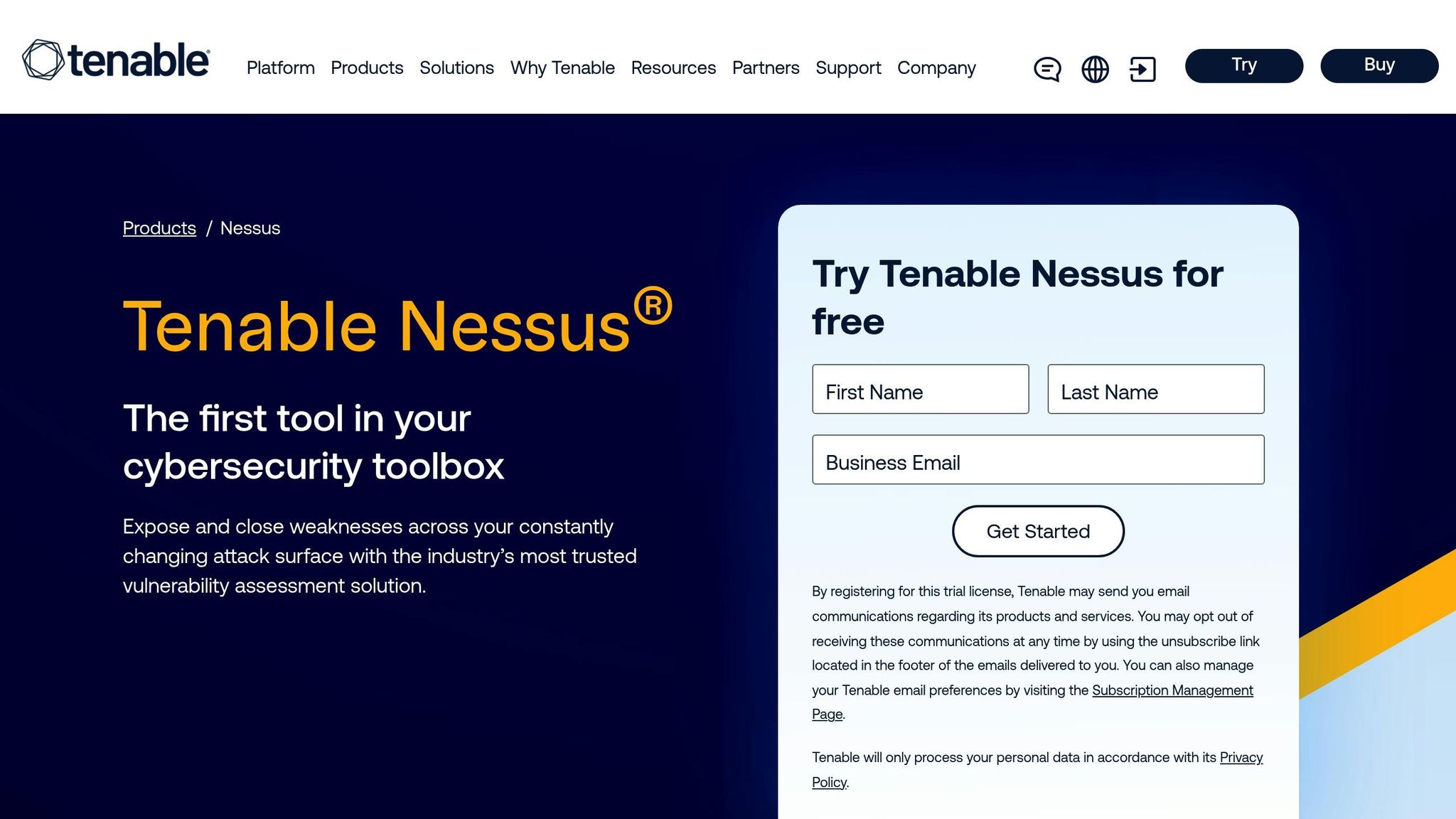
Tenable Nessus has become a go-to tool for vulnerability scanning, trusted by over 43,000 organizations worldwide, including 60% of Fortune 500 companies and 40% of Global 2000 enterprises. Its reputation stems from its ability to proactively identify threats while simplifying risk management and compliance monitoring efforts [24].
One of Nessus’s standout features is its ability to detect critical vulnerabilities while keeping false alerts to a minimum. With an impressively low false positive rate of just 0.32 per million scans and coverage of more than 77,000 CVEs through 210,000+ plugins, Nessus ensures organizations can focus on real threats without being bogged down by unnecessary noise [24]. This precision is a game-changer for teams managing vulnerabilities across diverse systems, devices, and applications.
Shai Morag, Chief Product Officer, highlights the platform’s evolution to address modern security challenges:
"We’ve optimized Nessus to meet the evolving needs of our customers, empowering informed vulnerability prioritization strategies to address these critical few." [22]
This emphasis on prioritization helps organizations cut through the clutter of vulnerabilities with high CVSS scores but low actual risk. Nessus’s risk-based approach reduces vulnerability overload by approximately 97%, enabling teams to focus on the top 3% that pose the most significant threats [26].
Features for Compliance
Tenable Nessus stands out in compliance audits and continuous monitoring with a range of features designed to streamline these processes. Its dual-functionality scans for vulnerabilities and compliance issues simultaneously, providing detailed insights into server configurations, patching statuses, and network-wide vulnerabilities [25]. This capability allows teams to identify trends in non-compliance and adjust security measures accordingly.
Nessus supports CVSS v4 and EPSS, ensuring compatibility with a wide range of compliance frameworks [22]. Its built-in compliance checks against industry standards help organizations maintain security baselines without the need for additional tools or workflows [24].
One of the platform’s most valuable tools is its Predictive Prioritization technology. By leveraging machine learning, Nessus assigns a Vulnerability Priority Rating (VPR) and Asset Criticality Rating (ACR) to pinpoint and prioritize the most pressing vulnerabilities. This targeted approach ensures limited resources are spent addressing the most critical risks [26].
Customizable scanning templates and actionable reports make it easier for teams to turn raw data into strategic decisions. These reports provide clear, prioritized remediation guidance, whether for IT infrastructure, cloud environments, web applications, or external attack surfaces. With support for both authenticated and unauthenticated scans, Nessus adapts to various environments [24].
Integration and Automation
Nessus also excels in integration, working seamlessly with tools like ServiceNow and Splunk to automate asset discovery and centralize vulnerability insights. This integration simplifies threat management by consolidating data into a unified platform [27]. Dynamic plugins further enhance scanning capabilities, ensuring coverage for newly identified vulnerabilities, while daily automated updates keep threat intelligence current [24].
For organizations planning to deploy Nessus, Tenable suggests staggering agent rollouts over a 24-hour period to avoid bandwidth issues. Pricing begins at approximately $3,590 annually for Nessus Professional, with Nessus Expert offering additional features like external attack surface scanning and cloud infrastructure assessments [24].
As one user noted:
"Nessus performs perfect assessments to help cybersecurity admins take the proper mitigation methods to address vulnerabilities, including missing patches, software flaws, and misconfigurations – across a variety of OS, different types of OEM, and applications." [23]
7. Tool Comparison: Key Features and Benefits
As compliance audits become more complex, understanding the strengths of different tools is essential. Choosing the right compliance audit solution means evaluating how well each platform aligns with your regulatory needs, budget, and operational priorities. The tools mentioned here cater to a variety of market segments and compliance frameworks, with pricing models designed to reflect their features and target users.
Pricing structures range widely: subscription-based plans for small businesses typically cost between $50 and $500 per month, while enterprise-level solutions can range from $10,000 to over $100,000 annually, depending on factors like customization, integrations, and the number of users. Pay-per-user models generally fall between $20 and $100 per user each month [29].
| Tool | Primary Focus | Key Differentiator | Pricing Range | Best Suited For |
|---|---|---|---|---|
| ScoreDetect | Digital content protection | Blockchain timestamping, 95% web scraping success rate | $11.31–$12/month (Pro) | Content creators, legal firms, media companies |
| Cryptoworth | Crypto asset tracking | Real-time portfolio monitoring | Enterprise pricing | Financial institutions, crypto businesses |
| InvGate Asset Management | Software asset compliance | Automated license tracking | Mid-market pricing | IT departments, software-heavy organizations |
| Cryptio | Digital asset compliance | Comprehensive audit trails | Enterprise pricing | Accounting firms, financial services |
| Ledgible | Crypto accounting | Tax-focused reporting | Subscription-based | Crypto traders, tax professionals |
| Tenable Nessus | Risk management & vulnerability scanning | Robust vulnerability detection | $3,590+ annually | Cybersecurity teams, enterprise IT |
This comparison highlights each tool’s unique advantages and pricing. For instance, ScoreDetect stands out with its blockchain integration, offering verifiable proof of ownership without storing digital assets. This feature is especially beneficial for media companies, legal firms, and academic institutions where content authenticity is a priority.
Automation is another key feature across these platforms, helping to save valuable time during audit preparation. Integration flexibility is crucial for enterprise users, and ScoreDetect delivers here by connecting with over 6,000 apps via Zapier. This integration helps streamline workflows, eliminate data silos, and create cohesive compliance processes across various systems.
Industry-specific features also set these tools apart. For example, Vanta is tailored for tech and SaaS companies needing SOC 2, ISO 27001, and HITRUST CSF compliance [30]. LogicGate caters to financial institutions with rule-based workflows and regulatory content integrations [30]. Meanwhile, Safefood 360° specializes in helping food businesses achieve certifications like GFSI, FSMA, and BRCGS [30].
User support and ease of deployment are critical for successful implementation. Drata offers 24/7 chatbot support and live chat, though its learning curve can be challenging [28]. AuditBoard provides an intuitive interface and expert global support, though it comes at a premium price [28]. Sprinto balances user-friendliness with responsive customer support, though customization options could be improved [28].
Real-time monitoring is another feature that separates proactive compliance tools from reactive ones. Hyperproof automates evidence collection and tracks control effectiveness across multiple frameworks [29]. ZenGRC provides continuous monitoring with customizable audit management, while Drata offers real-time visibility into compliance and security status [29].
Ultimately, selecting the right tool depends on your organization’s compliance needs, technical setup, and budget. Large enterprises with complex regulatory demands might find platforms like AuditBoard or LogicGate more suitable, while smaller businesses could benefit from cost-effective, subscription-based solutions like ScoreDetect or Sprinto.
Conclusion
Picking the right compliance audit tools in 2025 is like building a strong shield to protect your organization from hefty fines and legal troubles. With regulations tightening and penalties becoming harsher, having a solid compliance audit strategy isn’t just helpful – it’s absolutely necessary.
Here’s why: the right tools can save your organization a fortune. On average, companies using robust compliance tools save about $2.86 million by spotting and addressing risks early, before they spiral out of control [32]. Plus, bringing a compliance-focused executive into the C-suite can cut costs by an additional $1.25 million [32].
At the heart of modern compliance auditing is automation. The tools discussed here showcase how features like automated tracking, real-time monitoring, and advanced workflows reduce manual errors and send immediate alerts. For instance, ScoreDetect’s blockchain timestamping provides undeniable proof of ownership without storing actual digital assets – perfect for content creators and legal teams managing intellectual property. This kind of automated verification also adjusts effortlessly to new regulatory requirements.
Staying ahead of changing regulations is another critical factor. With 53% of cybersecurity professionals emphasizing the importance of continuously improving security practices [31] and the increasing demand for ISO 27001 certification [31], it’s clear that tools capable of evolving with regulatory standards are a must. The platforms highlighted here are designed to support a range of compliance needs, from GDPR and HIPAA to crypto asset regulations.
Modern compliance tools also centralize everything – audit trails, risk assessments, and policy documentation – making it easier to manage sensitive data securely. But technology alone isn’t enough. Success comes from embedding compliance into your everyday business processes. Use real-time dashboards to track compliance metrics, prioritize tasks based on regular risk assessments, and schedule internal audits to keep everything running smoothly [33].
Whether your focus is on safeguarding digital content, managing crypto assets, or ensuring software licensing compliance, integrated compliance tools can turn the audit process from a reactive chore into a proactive advantage. With the right strategy and tools, compliance becomes not just a necessity, but a strength.
FAQs
How does ScoreDetect leverage blockchain technology to improve compliance audits?
ScoreDetect takes compliance audits to the next level with the power of blockchain technology, offering a tamper-proof record for your digital content. By generating a checksum – a unique fingerprint of your assets – it secures copyright protection and establishes undeniable proof of ownership, all without the need to store the actual files.
This method not only bolsters your compliance measures but also streamlines verification, helping you manage digital assets with greater trust and clarity.
What are the main advantages of using Cryptoworth for cryptocurrency compliance management?
Cryptoworth makes managing cryptocurrency compliance easier by providing tools that automate transaction tracking, handle tax reporting, and prepare for audits. These features cut down on manual work, reduce the chance of mistakes, and help businesses keep up with shifting regulations.
The platform also prioritizes secure data management and delivers precise financial reporting. This allows companies to simplify audits and adapt more efficiently in an industry that’s constantly evolving.
How does InvGate Asset Management help lower costs during software license audits?
InvGate Asset Management makes software license audits less costly by providing detailed insights into software usage and licensing. With this visibility, organizations can allocate licenses more efficiently, cutting down on unnecessary expenses while staying compliant.
The platform’s advanced tools also pinpoint underused or unsupported software, helping businesses trim excess costs and reduce the risk of audit penalties. By streamlining the audit process, InvGate Asset Management delivers a straightforward and cost-saving approach to managing licenses effectively.

